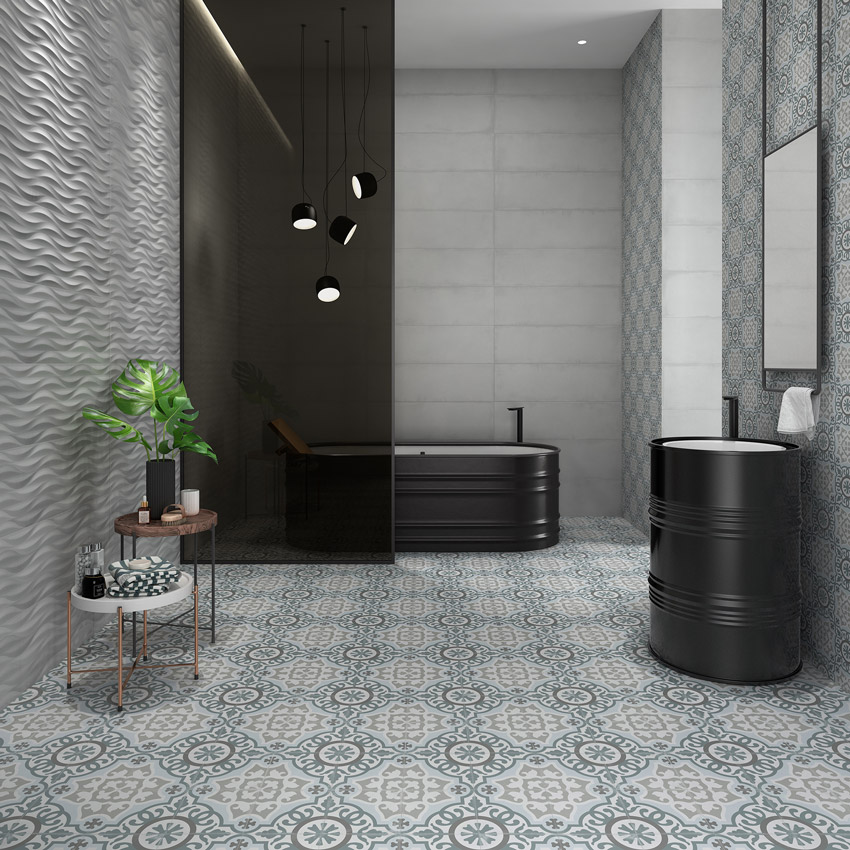Technology Transforms Tile
TILE SPECIFICATION BASICS
Standards and Specifications

Photo courtesy of Tile of Spain
Recent standards and specifications have been adopted to assist specifiers in taking advantage of new possibilities in gauged porcelain tile products.
American National Standard Institute (ANSI) standard specifications have been adopted for ceramic and glass tiles, and for installation materials such as mortars adhesives and grouts, including:
- ANSI A137.1:2017: Standard Specifications for Ceramic Tile
- ANSI A108/A118/A136.1:2017: Specifications for the Installation of Ceramic Tile
- ANSI A137.2:2013: Standard Specifications for Glass Tile
The ANSI American National Standard Specifications now in use and applicable to specifying the gauged porcelain tile discussed in this course were first adopted in 2016 are:
- ANSI 137.3/A108.19:2017: Tile Standard Specifications for Gauged Porcelain Tile and Gauged Porcelain Tile Panels/Slabs (Material and Installation Standards)
Products under the standard include:
- Gauged porcelain tiles: less than 1 square meter
- Gauged porcelain tile panels/slabs: 1 square meter or larger.
Major Tile Resources
- The Tile Council of North America (TCNA) also publishes guidance, including the 2019 TCNA Handbook for Ceramic, Glass, and Stone Installation.
- The Ceramic Tile Distributors Association (CTDA) provides resources for specifiers, as well as homeowners and the industry.
- The Ceramic Tile Education Foundation (CTEF) and Advanced Certifications for Tile Installers (ACT) are tile installer certification programs.
- International regional organizations, such as ACER (the Spanish acronym for manufacturer’s association in Spain) and ITC (the Spanish acronym for the technological institute of ceramics) work with ISO committee working groups and provide research and development and promotion of innovation. University collaborative initiatives with both these organizations and leading graduate faculties like Harvard Graduate School of Design continue to push the boundaries of possibility with ceramics.
ISO also continues to work on standards for Europe, where these products have been in use much longer than in the United States. There is considerable useful cross pollination between many of the working group stakeholders and ANSI and ISO standards policy makers.
- Tile is an important component not only as a cladding or surface finish but also in systemic design for the Collaborative for High-Performance Schools, the International Green Construction Code, Passive House, and other performance building platforms.
Installation Options
Specifiers should also be aware of opportunities for collaborative installation presented by new gauged porcelain tile products. Although experienced and preferably certified tile installers are critical to most tile installations, new gauged tiles are often not traditional mortar systems. The flexibility of gauged tiles means that other associated trades with applicable skills can often play a major role, particularly in the more creative custom designs now possible. Examples include:
- Facades: engineering/scaffolding contractors, carpenters
- Pavers: landscape design/build contractors, masonry contractors
- Worktops: stone fabricators
- Furniture and veneers: custom furniture fabricators and millwork shops
Basic Tile Categories
There are a number of ways to categorize tile types to narrow the field for specific applications. For example, tile can be ranked by percentage of water absorption as determined in testing. High-absorption tiles are produced at lower firing temperatures and available in many finishes and color choices but suitable mainly for vertical areas. Despite their relatively high porosity, these products are perfectly suited to wet areas due to their imperviously glazed surface and the natural sheeting occurrence due to gravity.
Many moderate- and low-absorption tiles can be used in various applications that are subject to occasional moisture. The lower the moisture absorption percentage, the more traffic and other stressors they can withstand.
At the other end of the spectrum, porcelain tile has extremely low water absorption (less than 0.5 percent) and can be used in any interior or exterior application, including those experiencing heavy or wheeled traffic and even submerged applications.
In another way to evaluate a specific tile’s applicability, the Porcelain Enamel Institute rates glazed tile by hardness. It is important to note that the actual test for abrasion resistance is a visual observation. Lighter colors and collections with variegated pattern or sheen levels will always have a higher PEI rating than darker and/or solid color collections with consistent surface finishes.
- Group I, Light Traffic: These tiles can be used in residential bathroom floors, such as a guest bath where bare or stocking feet are the norm.
- Group II, Medium Traffic: These tiles are designed for use in interiors where little abrasion occurs, so not recommended anywhere exposed frequently to exterior footwear or soil like kitchens, entries, or stairwells.
- Group III, Medium-Heavy Traffic: These tiles can be used anywhere inside a residential home, including kitchens and baths.
- Group IV, Heavy Traffic: These are very hard tiles that can be used in homes or in light to medium commercial areas.
- Group V, Extra-Heavy Traffic: These tiles can be used anywhere.
CONCLUSION
The natural material and unique firing process of ceramic tile give it exceptional durability, ease of maintenance, resistance to fire and flood, and last but not least, beauty that has given pleasure to generations. A growing number of state-of-the-art manufacturers are using emerging technologies to create products that take these natural characteristics to a new level, creating tile that is thinner, lighter, safer, and more versatile than conventional tile, but with the same or improved mechanical, structural, and environmental performance. Manufacturers should be able to assist architects, designers, and specifiers in evaluating the expanded choices now available and how they can be used effectively in specific applications.
A global industry leader, Tile of Spain is the international brand representing 125 ceramic tile manufacturers belonging to the Spanish Ceramic Tile Manufacturers’ Association (ASCER). Its objective is to support and promote Spain’s tile manufacturers and industry worldwide. www.tileofspainusa.com
 |
A global industry leader, Tile of Spain is the international brand representing 125 ceramic tile manufacturers belonging to the Spanish Ceramic Tile Manufacturers’ Association (ASCER). Its objective is to support and promote Spain’s tile manufacturers and industry worldwide. www.tileofspainusa.com |









